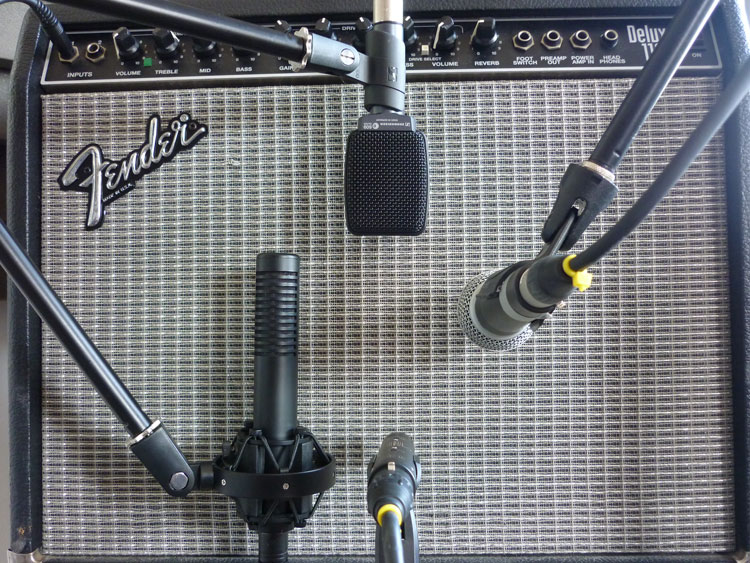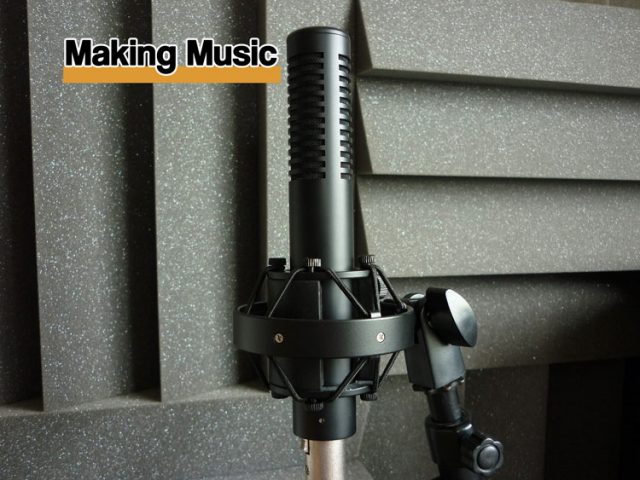Last Updated on September 11, 2017 by Andrew Culture
From: studiospares.com
RRP: £87.00
Cost (at time of writing): £59.00 (inc VAT)
What are Ribbon Microphones?
Originally designed for the film industry at the dawn of the ‘talkies’, ribbon microphones have a figure-of-8 pattern that rejects sound from the sides (which is where they would place noisy film cameras) and are the original basis of certain stereo miking techniques introduced by Alan Blumlein: the self-titled Blumlein Technique and the Mid/Sides technique. However, since the 1950s, the capacitor microphone has slowly become the engineer’s go-to mic due to its wider frequency range and greater output. Much like progress in any area involving technology, ribbon microphones became less widespread when capacitor microphones arrived and became more affordable.
So why are Ribbon Mics making a comeback?
The inherent ‘excellence’ of capacitor microphones and their ability to pick up high frequencies meant that some instruments that have a fairly strident sound, such as brass, might be in need of some remedial EQ to make them sit in a mix properly.
Also, with the advent of digital recording, there is no longer a problem with high frequency loss as when recording to tape and so bright sounds stay, well, bright! These are just two reasons why the ribbon microphone has started to make a recent resurgence.
Boasting a darker tone and a subjectively flatter response until those very high frequencies, ribbon microphones are increasingly being used once more and all manner of manufacturers are producing them. Golden Age Projects, Sontronics, Coles and AEA all include ribbon microphones in their line-up, with the Coles 4038 probably being the most ubiquitous and resolutely unchanged since its design by the BBC in the 1950s. The Studiospares S300 is in auspicious company then but, at this budget price, can it really be held up for comparison?
To be fair, I don’t think this is the main aim of Studiospares team, just as their own-brand capacitor models aren’t expected to be in the same league as Neumann and Brauner. What they do however is enable the budget-conscious dabbler and the project-studio owner to enlarge their microphone collection without breaking the bank.
Studiospares S300 Ribbon Mic – What’s in the box?
So, to the microphone itself. The S300 comes packaged in a well-made, padded, wooden box and soft bag for protection. It is suggested that ribbon mics are stored standing up to prevent the ribbon element from sagging and the box is sturdy and large enough to allow this. It also comes with an elasticated shock mount and associated mic stand adapter to enable mounting on a 3/8” stand, although there is no room in the box to store them, so they need to be carried separately. This isn’t necessarily a problem, but the mic is quite chunky and wouldn’t fit a standard mic holder if the included one goes missing.
The body of the mic is cylindrical, sturdy and weighs 292 grams, but the shock mount again, is well made and is more than up to the job of holding it in place. The mic is quite a snug fit in the cradle and, although there is a knurled screw fixing to hold it in, there isn’t any danger of it falling out if you forget to do this.
S300 Technical Specifications
There is no frequency response plot or technical details included but a sticker on the packaging states that the range of the mic is 20Hz to 18kHz, although no specifics are given as to how flat the response actually is. This may suggest the standard +/- 3dB deviation up to a point, but this cannot be confirmed. Maximum SPL is quoted as 150dB SPL @ 1kHz, which compared to some other ribbon mics is impressive to say the least, although I wouldn’t want to put it inside a kick drum just in case.
The S300 requires 48v phantom power for the onboard preamp to work effectively, although there is an output without it but it is too low to be usable without being too noisy. Even with the preamp powered, there was still some inherent noise from the microphone when compared to my capacitor mics, but it is low enough not to be noticed when close miking instruments.
Studiospares S300 – comparison test


As I had primarily bought the S300 for miking electric guitar amps, my first test was a comparison with some other mics that I regularly use for this purpose (recorded examples can be heard below).
As expected, the S300 gently rolled off the top end of the guitar sound and was perceptibly ‘warmer’ overall. This was possibly due to the proximity effect exhibited by figure-of-eight pattern microphones, but was easily remedied either by using a high pass filter to round off the lower frequencies or by moving the mic further from the source.
On a clean sounding amp, the recorded sound of the S300 was less present than a Shure SM58 that seemed to have more bite, but overall was still a pleasant sound. A greater difference can be heard however with a distorted amp where the SM58 and Sennheisser E609 had a punky-sounding, mid-frequency rasp and the Sontronics STC-10 had a slightly more fizzy top end. The S300 by contrast had a much more creamy sound to it, again probably due to the proximity effect, but the mic reacts well to EQ should this not be exactly the sound you are after.
On hand percussion, such as shakers, again the mic calmed the high mids and pulled the sound backwards a little, as it did on acoustic guitar where it tamed string buzz which might normally trouble a capacitor mic, but still kept the required detail to the sound. Finally, on spoken voice, the S300 rounded off the top end and didn’t exhibit the sibilance normally present in the male test voice, but even with some EQ work some of the clarity was lost and so didn’t project the voice quite as well as other mics used for this task.
As with all microphones that are anything other than uni-directional, the room sound plays a part in what the S300 captures overall, whether good or bad and so care needs to be taken when positioning. In large or well-treated rooms, this may not be much of a concern but in a typical bedroom or project studio this interaction with the room could have a noticeable effect on the recording.
Studiospares S300 Ribbon Microphone – Conclusion
The Studiospares S300 is an affordable entry-level ribbon microphone if you are looking for a different colour to your recordings. It captures a darker sound, having less sensitivity to high frequencies and delivers a smooth overall result.
The price belies the build quality of the microphone and the included extras and, although it is not going to compare to other ribbon microphones costing ten-times as much, it is another choice if you are into experimenting with different types of mics rather than always reaching for the EQ. It won’t suit all sound sources or styles of music, but it is a good addition to a burgeoning mic locker.
Pros
- Build quality
- Included extras
- Gives another choice of colour for recordings
Cons
- Won’t suit all sources, but not many mics do
- Have to carry the shock mount separately
Parameters of the comparative tests
Amp Used: Fender Deluxe 112Plus (1 x 12”)
All mics halfway between outer edge and dust cap (3 inches into cone)
All mics positioned 1 inch away from speaker
All mics on axis
Any pads or filters set flat
Mics used:
Studiospares S300 (Figure 8)
Sontronics STC-10 (Cardioid)
Shure SM58 (Cardioid)
Sennheisser E609 (Hypercardioid)
Preamp/interface: Focusrite Scarlett 18i20
Gain added to signal until inputs peaked around -11dB (all recorded files have been level increased by identical amounts for playback but otherwise no additional processing added)
One pass of each of the two sounds (clean and distorted) with all mics open, to ensure that playing dynamics didn’t affect the recorded sound.

















